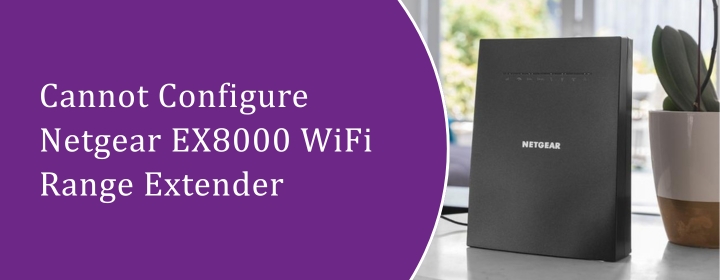Netgear EX8000 WiFi range extender was supposed to make your WiFi network spread, instead it refuses to configure the device. You’ve tried everything but either the page doesn’t load or it keeps looping you back to zero. The EX8000 is an absolute beast once it’s running but sometimes it tests your patience. So, if you’re stuck at ‘cannot configure’ and have made up your mind to throw it out then don’t.
Here in this guide, we will walk you through exactly what to do with step-by-step to configure Netgear EX8000 WiFi range extender.
First, What Is Actually Going Wrong Here
The EX8000 is one of those tri-band devices. It is perfect once it’s running but it’s a little too smart for its own good sometimes. The main issues usually come down to:
- Your device not connecting to the extender’s temporary setup network properly.
- Browser cache or DNS getting in the way of the setup page.
- Old saved settings on the extender (especially if it’s not brand new).
- Incorrect WiFi band selection or interference from the main router.
So, if you’re stuck at ‘cannot configure’ and made up your mind to throw it out then don’t. Follow these steps for Netgear WiFi extender setup.
Steps to Configure Netgear EX8000 WiFi Range Extender
Step 1: Forget everything and reset it properly
Before you reset the device, you should be clear. Usually, Netgear WiFi extender reset confuses a lot of people and they’re not able to do it right. To do it right:
-
- Make sure the extension is plugged in and turned on.
- Wait until the power light is a steady white or amber color.
- Now take a paperclip or a pin.
- You need it insert it into the tiny hole for 15 seconds until power LED will blink.
After that, you need to give it some time to fully reboot.
Step 2: Connect directly to the extender
This part messes up for a lot of people. You can’t do setup if your phone or laptop keeps switching back to your main WiFi.
- Go to WiFi settings.
- Look for extender network.
- Connect to it. No password.
- Once connected, open a browser.
- Here, you need to enter mywifiext.net or 192.168.1.250 to reach the mywifiext interface.
If you are unable to reach mywifiext interface then try some other browser, clear cache or use incognito mode.
Step 3: When the setup page finally opens
- You should see the Netgear installation wizard. You have to choose whether to complete the setup as range extender or AP.
- Choose Range Extender unless you’re intentionally setting up an access point with an Ethernet cable.
- Now it’ll scan for your WiFi networks. This is another spot people get stuck. If your main WiFi isn’t visible then it can be because your router is using a hidden SSID or it is on an unknown channel or using Smart Connect that merges 2.4GHz and 5GHz together.
- You can temporarily disable Smart Connect on your router to help the EX8000 detect both bands separately.
Step 4: Select your main WiFi
- There are two networks: one for 2.4GHz and one for 5GHz. Pick both and enter your router’s password.
- After that, screen will ask whether to keep the same SSID or rename it for extended network.
- We suggest you to keep the names different from your main WiFi at least during setup. It helps avoid confusion later.
- Then click on ‘Next’ and let it do its work. It will take few minutes to connect, verify, and configure.
- If you get a failed to connect message then double-check that you typed the correct WiFi password. A single typo can throw it off.
Step 5: Wait for the lights
- Once the Netgear WiFi extender setup finishes, your extender will reboot automatically.
- Now check the LEDs:
- Power light has solid white color.
- Device to router connection should be solid white or blue which means good connection.
- Client connection also white or blue when your devices connect.
- If you see red or amber light on the extender then it means extender placed is too far from the router. Place it halfway between your router and dead spot to fix the light.
Step 6: Connect your devices to the extended WiFi
- Now, disconnect from ‘NETGEAR_EXT’ and go to your WiFi list again.
- You should see your new extended networks. Connect to the one you just created and test it.
- If it’s working, you’re done.
- If not then here is what people go wrong mostly: Sometimes the extender shows as connected in your device but there is no internet. That usually means the extender didn’t sync properly with your main router’s DNS or IP range.
To fix this, you have to:
- Reboot your main router.
- Wait till internet is up.
- Then reboot the extender.
Give it a minute or two after both are online, it should start passing internet through.
Step 7: Login and Customize settings
- If you want to check the status or change anything later, open: mywifiext.net
- And log in with your admin credentials (the ones you set during setup).
- Inside you’ll see signal strength, connected devices, and firmware info.
- Speaking of firmware, update it if it’s out-dated then setup failure can be because firmware is old.
- To update the firmware: Go to Settings then Firmware Update and check if new firmware is available. If new update is available then let it downloads and install. The extender will reboot once done.
Final thoughts
In short, we can say that the Netgear EX8000 WiFi range extender is powerful but its setup can be frustrating if you miss a single small thing. The good news is, once you configure it correctly, it stays rock-solid. If you still face issues after trying everything, factory reset it again and set it up using a laptop or desktop via Ethernet instead of WiFi. That bypasses all the interference. You just plug an Ethernet cable into the extender, open a browser and go to mywifiext.net; rest, the process is the same with more stability. Anyway, don’t overthink it. Most of the ‘cannot configure’ problems with the EX8000 come down to WiFi interference or cached network data. Clear it all, start fresh, and go step by step. It’ll work.


